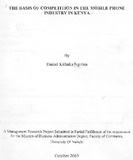| dc.description.abstract | Following the liberalization of the economy in late twentieth century, where the government
wanted to shift from state controlled economy to one where private sector plays a pivotal role, with
the aim of increasing efficiency and at the same time increase revenue, the veil on Telcom sector
was lifted, giving birth two sectors Telkom and Mobile phones. Consequently, the Government
decided to issue two mobile phone licenses. Kenya Post and Telecommunication Corporation
(KPTC), a monolithic state-owned telecom giant of mean repute sired a subsidiary named
Safaricom Limited while the second license was issue to Celtel (Formally Kencell
Communications) .
.,
The main motivation for this study on the basis of competition in the mobile phone industry in
Kenya is the fact that the two dominant players in this industry have been engaged in fierce rivalry
in their effort to outmaneuver each other in the market so as to control market share. This is
compounded by the fact that the market penetration rate is only about seven per cent of the Kenyan
population of eligible subscribers. Despite existence of large untapped market potential, these two
companies have been involved in concerted competitive rivalries that are geared towards subscriber
acquisition and customer loyalty. This has left one wondering why with all this large market
potential, have these two companies been engaged if fierce rivalry and on what basis are they
competing .9({in order to gain a leading market share . '
Research methodology used was mainly through face-to-face interviews of target respondent and
information gathered was validated using existing published data. Most respondents were asked to
v
provide information on topical issues as per the questionnaire and this helped in achieving the
objectives of this study.
From the results of this study, it was clearly evident that these two companies have been applying
various strategies as their basis of competition in an effort to win more subscribers and main longterm
loyalty. Key among their basis of competition was seen to be cost of their products and
services, advertising, customer care, network infrastructure, Supply Chain Management Policies,
Corporate Social Responsibility and human resource, among others. These strategies were seen to
have been key critical success factors on which these companies have been using as a basis of
competition.
From the findings of this study, it is clearly evident that the two firms have managed to be
successful thus far revolutionalising telecommunication industry in Kenya as compared to TKL.
The future of their business will depend on how well they are able to adjust their strategic intents to
the volatile environment that is technology based and with the licensing of a third operator, their
basis of competition is going to be more intense.
It is therefore recommended that a further study be carried out so as to capture customer demand
trends for service and how the third operator and licensing of Second National Operator (SNO) is
going to influence and affect the existing basis of competition in this industry and also how the
realization of East African Community is going to affect the Kenyan mobile telephony | en |

